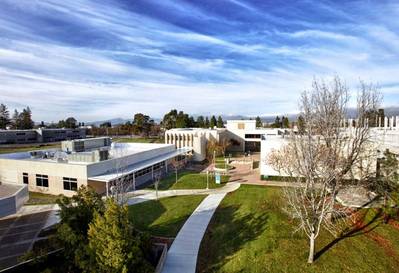Sandia’s Combustion Research Facility Celebrates 40th

The Combustion Research Facility on the California campus of Sandia National Laboratories opened March 6, 1981. (Photo courtesy of Sandia National Laboratories)
The weather on March 6, 1981, was nothing too remarkable for the San Francisco Bay Area — a little drizzle with temperatures in the 50s and fairly calm wind. The remarkable event that day was taking place on Sandia National Laboratories’ California campus, but even those who participated in the opening of the newly built Combustion Research Facility had no idea how much that institution would change the world.
“There isn’t a single modern vehicle on the road today that hasn’t benefitted from the work done at the CRF,” said Bob Carling, who spent 27 years doing research at the facility.
“It was designed to provide an understanding of combustion in response to the energy crisis,” explained Craig Taatjes, who supervises physical sciences research at Sandia, referring to the 1970s oil embargo by members of OPEC that drove a surge in gasoline prices and a supply shortage in the United States. At that time, the nation had grown increasingly dependent upon imported oil and needed to find ways to be more energy self-sufficient.
“The other part of the vision was that it be a collaborative facility where researchers from around the world could participate, teach us and learn from us,” Taatjes added. “One of the big visions was to bring together the applied offices and fundamental offices in one place.”
Senior manager Chris Shaddix, who headed energy and transportation sciences before being recently appointed to manager another department at Sandia, said that having applied science researchers and fundamental scientists under one roof meant that sometimes the applied scientists would modify techniques to work in their environment.
“That would lead to new insights that were useful to doing more fundamental studies. That was a common thread,” Shaddix said.
Center of innovation
There is a list of technological advances that didn’t exist before researchers at CRF invented or began using them in new ways.
Ion imaging, developed in the late 1980s at the California facility, uses powerful lasers to ionize gas molecules and projects the resultant ions onto a two-dimensional detector. The position that the ions strike on the detector reflects the speed and direction the molecules were traveling when they were ionized, information that can be used to understand the details of the chemical reactions that formed the molecules. The technique was a new method for understanding fundamental chemical physics processes that had never before been documented.
“That ion imaging is used in hundreds of labs around the world now,” pointed out Sarah Allendorf, CRF’s director, “and is a foundation for other types of experiments that have expanded our understanding of gas phase chemistry.”
Other technologies also developed at CRF include: Chemical Kinetics, a software package written to calculate combustion chemistry and now used by industry around the world; a process called Rapid Reduction of Nitrogen Oxides to help clean up engine emissions; as well as using photo-ionization mass spectrometry to unravel complex combustion chemistry and atmospheric chemistry.
“And most recently ducted fuel injection is the big one,” Taatjes said of the technology being developed by researcher Charles Mueller to fine-tune the fuel-air mixture in diesel engines by controlling the flow of fuel into the combustion cylinder.
“It’s offering essentially an elimination of soot from diesel engines, which would be a huge, huge breakthrough,” Shaddix added.
Assisting American industrial development
Carling recalls how other breakthroughs drove innovation at Sandia and in the private sector.
“It took a while for the engine companies to really understand the value of what we can provide them as they design these engines,” he said. “As time went on, they became more and more dependent upon understanding what was going on inside the cylinder which we were uncovering.”
Those business partnerships extended beyond engine makers, driving innovation across sectors including steelmaking, glassmaking and energy production.
“They do work in their own labs, where we’ve done the pre-competitive research that is shared publicly, and they will go do specialized, proprietary research,” Allendorf explained. “The state of American industrial research has changed massively in the last 40 years. Many of those industries had their own research labs, which we would complement. Many of those research labs just don’t exist anymore. Our pre-competitive work allows our industrial partners to focus their precious research dollars on the pieces that is their competitive advantage.”
All of this is just the tip of the iceberg keeping the CRF relevant in the 21st century and driving innovations in the future.
“It’s safe to say that every group of researchers that’s ever been at CRF has essentially been world leaders at what they do,” Shaddix said. “We expect that actually at CRF. After a few years at Sandia, we expect you to be a world leader at what you do.”






